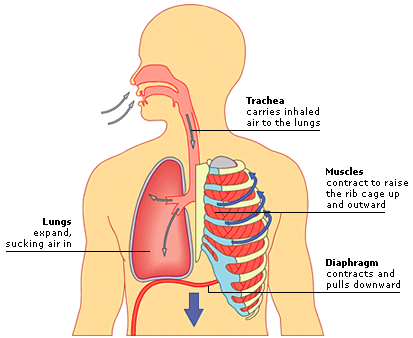DK Human Body: Lungs
The main organs of the respiratory system are the lungs—two large organs that expand and contract. Each has a network of airways that end in tiny pockets called alveoli, where oxygen enters the blood and carbon dioxide leaves—a process known as Gas exchange.
The lungs rely on surrounding muscles to make them expand and contract. Muscles between the ribs pull the rib cage up and out, making the chest expand and drawing air in, or relax to squeeze the lungs and force air out as the rib cage falls down and in. At the same time, the diaphragm (a dome of muscle beneath the lungs) contracts to suck air into the airway, or relaxes and rises up to push air out.
The respiratory center of the brain regulates our breathing, even while we sleep, with the help of receptors in some of the large arteries. The receptors monitor the level of carbon dioxide in the blood, which rises when we are active, and tell the brain if we need to breathe faster to get rid of the carbon dioxide.
The passing of gases from the air into the blood, and from the blood back to the air, is called gas exchange. It takes place in the lungs, in tiny air pockets called alveoli.
Alveoli are like tiny bags of air with walls so thin that gases can pass through them. There are around 300 million alveoli in the lungs. Together they provide an area about as big as a tennis court for gas exchange.
Oxygen passes through the walls of the alveoli and the surrounding blood capillaries into the blood. The oxygen enters red blood cells and binds to a chemical called hemoglobin. Carbon dioxide passes out of the plasma (the watery part of blood) to enter the alveoli.


